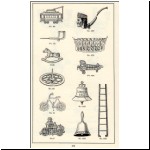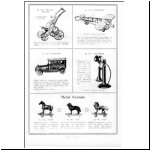|
Early
Tootsietoy Aircraft
by Clint Seeley edited by Robert Newson Clint Seeley's original text is in green, and my editorial additions are in blue. Put your mouse over the thumbnail images to see the picture caption, and click on the thumbnail to enlarge. The original version
of this article appeared in Modellers' World magazine, Vol.3
no.2,
Jan.1974.
Some of you may have read previous pieces in the English literature of the hobby concerning old toy automobiles, trucks, buses and so on, made in the United States since shortly after the turn of the century by the Dowst Brothers Company and its successors. These took on the brand name of Tootsietoys by the middle 1920s. Little has been written about other toys that they made, which included trains, boats, doll furniture and myriad tiny miniatures of animals, devils, birds, lanterns, shoes, flat irons and almost anything else which could be shrunk in three dimensions to a diminutive piece of cast metal. It was natural that this microcosm of the real world of the day should include one of the great novelties of the times, aircraft, real and imagined. This brief essay will concern itself with this neglected corner of toy history, in hopes of being some small remedy. On December 17, 1903, Wilbur and Orville Wright made four successful test flights of a heavier-than-air craft on the dunes at Kitty Hawk, on the coast of North Carolina. The spidery and fragile aircraft that accomplished this momentous and historic feat by the Wright brothers (who had earlier shared a career in the publishing business) apparently did not inspire the Dowst brothers (who had, even earlier, shared a career in the publishing business) to immortalise the craft by duplicating it in a metal miniature. However, after a Frenchman, Louis Bleriot, flew a similar motorised box-kite across the English Channel on July 25, 1909, to win a £1,000 prize offered by the London Daily Mail, the Chicago firm seemed to take a more participatory attitude. In 1910 the Bleriot monoplane was offered for sale in three sizes. The largest was a delicate casting 25/8 inches long with a 2¼ inch wingspan, and had separate moveable propeller and three turning spoked wheels. Whether the toy was inspired by the plane itself or by a very similar cast lead toy made in France is not known to this writer.     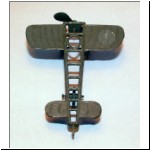 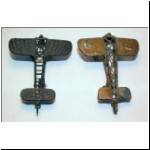 The
French toy,
thought to have been made by S.R., could have preceded the Dowst model
by a few months. They are almost identical, and one
must have
been copied from the other. The S.R. plane is shown in a 1916
advertisement
(reproduced in Ian Leonard's section of The Book of Penny Toys (ref.4)), however S.R.'s 1912 advert
(in
the same book) indicates that they already had a considerable range of
miniature horse drawn and motor vehicles at that date, whereas Dowst's
only motor vehicle was
the simpler 1911 Limousine. Coupled with the fact that the
Bleriot is so much in the style of other S.R. products, I would think
this came first and was copied by Dowst, or even (as Ian Leonard
suggests) S.R. may have supplied Dowst with the die. Two further
copies of the Bleriot are shown in the last picture (left), probably
French also. The
French toy,
thought to have been made by S.R., could have preceded the Dowst model
by a few months. They are almost identical, and one
must have
been copied from the other. The S.R. plane is shown in a 1916
advertisement
(reproduced in Ian Leonard's section of The Book of Penny Toys (ref.4)), however S.R.'s 1912 advert
(in
the same book) indicates that they already had a considerable range of
miniature horse drawn and motor vehicles at that date, whereas Dowst's
only motor vehicle was
the simpler 1911 Limousine. Coupled with the fact that the
Bleriot is so much in the style of other S.R. products, I would think
this came first and was copied by Dowst, or even (as Ian Leonard
suggests) S.R. may have supplied Dowst with the die. Two further
copies of the Bleriot are shown in the last picture (left), probably
French also.Dowst gave the larger model the catalogue number of 4482, a one-inch version 4491, and the smallest no recognition at all.
More than a decade later, in 1921, the catalogue shows no further additions to the selection of tiny aircraft, the doings of Eddy Rickenbacker, Baron von Richthofen, Errol Flynn, David Niven, Leslie Howard and other famous air aces of the First World War seemingly leaving the doughty Dowsts as uninspired as had the Wright brothers. Even today, one can buy handsome models of Spads, Sopwith Camels, Fokkers, Curtis something-or-others and other various derring-do 1918 flying machines. But not from Dowst in 1921. Or even in 1925. Maybe the history was just too new to seem worthy of notice. Or maybe the whole bloody war was looked upon as a bothersome nuisance that caused an inconvenient shortage of lead suitable for castings. 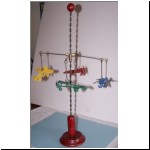  The
1925 catalogue did introduce an interesting novelty, however. The
Bleriot model was modified to put a small loop at the top near the
centre of gravity, and four planes were hung from a carousel of wires
which spiralled down a twisted pole to make a very attractive action
type toy. The planes were referred to merely as 'late models, each one a different
colour'. The gadget was
given catalogue number 160. The
1925 catalogue did introduce an interesting novelty, however. The
Bleriot model was modified to put a small loop at the top near the
centre of gravity, and four planes were hung from a carousel of wires
which spiralled down a twisted pole to make a very attractive action
type toy. The planes were referred to merely as 'late models, each one a different
colour'. The gadget was
given catalogue number 160.  In
1926 a neat little biplane was introduced and given catalogue no.4650,
but somehow looked ten years earlier. The wings were a separate
casting, painted red, while the fuselage, prop and wheels were yellow. In
1926 a neat little biplane was introduced and given catalogue no.4650,
but somehow looked ten years earlier. The wings were a separate
casting, painted red, while the fuselage, prop and wheels were yellow.   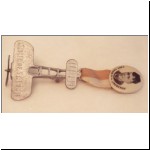 In 1927 the Spirit of Saint Louis carried Charles Lindbergh across the Atlantic on a rather well publicised solo flight. As a hasty souvenir of this event, Tootsietoys re-worked the old Bleriot in two versions. One had CAPT CHAS. LINDBERGH FIRST TO CROSS THE OCEAN IN AN AEROPLANE MAY 20. 1927 cast across the wings, while the other had SPIRIT OF ST.LOUIS cast, and a loop for a ribbon and lapel badge. Both are rare. 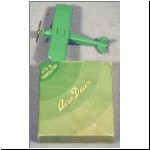  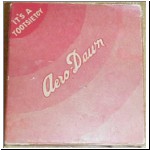 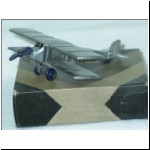 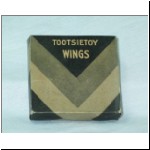 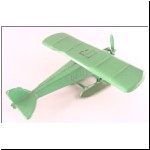  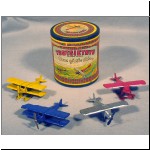    It was not until 1928 that they were able to introduce a slightly more accurate model of the plane, which they called the 'Aero-Dawn' (cat.no.4660), soon joined by a somewhat similar 'Wings' biplane (no.4675), and versions of both with ski-like pontoons which appeared only in sets. The wings and pontoons of these were made of stamped embossed tin, unlike the all lead predecessors. 'Wings' was the title of an Oscar winning movie released in 1927. The individual boxes for Aero-Dawn and Wings were coloured according to the colour of the model within, as with the Model A Fords. Louis Hertz (pages 208-9 in ref.5) recounts correspondence between Ted Dowst and the company's patent attorneys as to whether the Aero-Dawn could carry the same registration number as the real Spirit of St.Louis (which was N-X-211), and the decision to give it a different number (UX214) was taken because an application had already been made to register "N-X-211 Spirit of St.Louis" as a trade mark for a toy aeroplane. Both Aero-Dawn and Wings remained in production till the war. They were re-numbered 04660 and 04675 respectively in 1933 when fitted with rubber tyres on separate hubs, and were later given solid white rubber wheels. 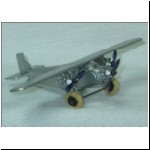    1930 saw the introduction of the first really carefully copied model of an American standard, the doughty Ford Tri-Motor, which did not seem to have been given a catalogue number, either in the single state or in a boxed set with a pair of them and a tin hangar, until 1931 when the set was designated no.5100 and the plane was no.4649 (then 04649 with rubber tyres from 1933).   This is the original hand-made
prototype for the Ford Tri-motor, made by Frank Bischof Jr., the young
genius who designed most of the great Tootsietoys of the 'twenties and
'thirties (information from (ref.2)).
His name also appears on the La Salle patent (see part 4 of the automotive article), and
see below for a similar prototype of the Lockheed Electra. The
second photo shows the model in an auction catalogue of a sale by SAS
auctions on 25 October 2003. The hammer price was £100. This is the original hand-made
prototype for the Ford Tri-motor, made by Frank Bischof Jr., the young
genius who designed most of the great Tootsietoys of the 'twenties and
'thirties (information from (ref.2)).
His name also appears on the La Salle patent (see part 4 of the automotive article), and
see below for a similar prototype of the Lockheed Electra. The
second photo shows the model in an auction catalogue of a sale by SAS
auctions on 25 October 2003. The hammer price was £100.  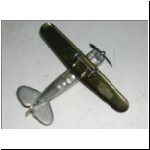  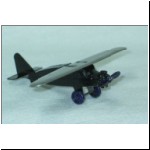  A series of 'Miniatures' was introduced in 1932, designed to retail for 5 cents instead of the customary dime, to compete with the spate of cheaper depression-spawned toys. Eight of the series were automotive. Two, given catalogue numbers 106 and 107, were aeroplanes. The first was a low wing two seater monoplane, the commoner one to survive today. The other was a high wing cabin monoplane. Both of these had cast lead fuselages and pressed tin wings.   The low-wing plane
was also produced with cast-in loops. The wire hook, which came
with the plane in the second photo, suggests that this was for a
carousel toy, similar to the earlier toy with Bleriot planes, but I
have no more information about this item. The low-wing plane
was also produced with cast-in loops. The wire hook, which came
with the plane in the second photo, suggests that this was for a
carousel toy, similar to the earlier toy with Bleriot planes, but I
have no more information about this item.  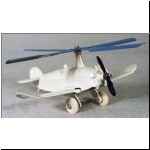   No.4650 made its debut in 1934 and was a typical autogyro (no sonny, it's not a helicopter, the top rotor being an unpowered freewheeling windmill, but it did make for steeper ascents and descents than the conventional fixed wing). Whether it impressed the lads of the day is not as certain as that it did inspire at least two foreign firms to copy the toy, line-for-line, shown in the fourth and fifth photos - a diecast version by Johillco in England, and a tinplate version by Rico in Spain (ref.2). Wieland and Force (ref.10) thought that the catalogue number quoted by Clint must be a misprint, since it duplicates the number of the earlier biplane, however it is clearly shown as 4650 in the 1938 UK leaflet (see part 7 of the automotive article).  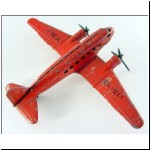 In
1935 a TWA Douglas Airliner was introduced and given catalogue
no.0717 (later 717).
When I was a boy at the time I had always thought it was
rather too stout and stubby for the Douglas DC3, and later bought the
Dinky model because it was a better likeness. Not until years
later when a professional airline pilot was visting my collection did I
learn that the Tootsietoy was a very faithful model of the Douglas
DC2! DC2? I didn't even know such a designation existed,
any more than the six wonders of the world, the third estate or two
blind mice. In
1935 a TWA Douglas Airliner was introduced and given catalogue
no.0717 (later 717).
When I was a boy at the time I had always thought it was
rather too stout and stubby for the Douglas DC3, and later bought the
Dinky model because it was a better likeness. Not until years
later when a professional airline pilot was visting my collection did I
learn that the Tootsietoy was a very faithful model of the Douglas
DC2! DC2? I didn't even know such a designation existed,
any more than the six wonders of the world, the third estate or two
blind mice.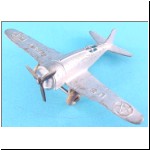 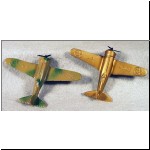 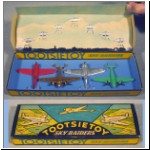   No.0119 US Army Plane first appeared in 1936, a classy 5c single canopied cockpit pursuit. During the 1930s, increasing emphasis was put on boxed sets of assorted toys, some of which were more homogeneous than others. Most sets had both planes and road vehicles, which annoyed me because of the disparity of scales. One of the exceptions was the box of aircraft shown above right.    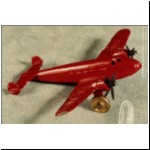 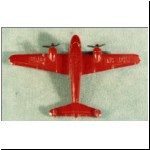    In
1937 the no.718 Waco Navy Bomber and no.719 Crusader Plane were brought
out to retail at 10 cents, while no.125 Lockheed Electra was the new 5
cents entry. The red
Lockheed Electra pictured above is the original master pattern model,
made of lead. Note the metal wheels mounted outside of the axle
supports and the lettering in raised panels on the wings. In
1937 the no.718 Waco Navy Bomber and no.719 Crusader Plane were brought
out to retail at 10 cents, while no.125 Lockheed Electra was the new 5
cents entry. The red
Lockheed Electra pictured above is the original master pattern model,
made of lead. Note the metal wheels mounted outside of the axle
supports and the lettering in raised panels on the wings.  Also the no.1030
rigid dirigible LOS ANGELES made
its bow, and was another lapse in scale to fit the 10 cents
price. Two pulley wheels at the top (the same castings as the
Graham wheel hubs) allowed it to run on a taught string. Also the no.1030
rigid dirigible LOS ANGELES made
its bow, and was another lapse in scale to fit the 10 cents
price. Two pulley wheels at the top (the same castings as the
Graham wheel hubs) allowed it to run on a taught string.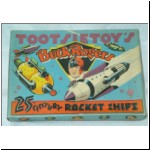        1937
also saw the three Buck Rogers rocket ships, catalogued as set
no.5460. These too ran on a stretched string, and marked the
entry of Tootsietoys into the space age. In contrast to the
reluctance of the firm to enter the air age, they beat history into
space on the inspiration of a funny-papers science fiction character
named Buck Rogers. His continuing serial saga graced the comic
pages of most of the newspapers of the day, and was so successful that
a competitor named Flash Gordon was also soon flourishing under the
auspices of another syndicate. Both continued in American folk
literature until history caught up a generation later and took the fun
out of the cartoon version of outer space. 1937
also saw the three Buck Rogers rocket ships, catalogued as set
no.5460. These too ran on a stretched string, and marked the
entry of Tootsietoys into the space age. In contrast to the
reluctance of the firm to enter the air age, they beat history into
space on the inspiration of a funny-papers science fiction character
named Buck Rogers. His continuing serial saga graced the comic
pages of most of the newspapers of the day, and was so successful that
a competitor named Flash Gordon was also soon flourishing under the
auspices of another syndicate. Both continued in American folk
literature until history caught up a generation later and took the fun
out of the cartoon version of outer space.  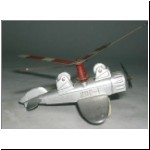 No.720
Fly-n-Giro came out in 1938, also designed to travel hung on a
stretched string. In this case the string also made the rotor
turn by
passing around the spindle. No.720
Fly-n-Giro came out in 1938, also designed to travel hung on a
stretched string. In this case the string also made the rotor
turn by
passing around the spindle.  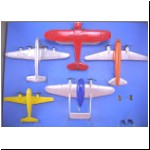 These photos show the
boxed sets in their 1938 art deco packaging. These photos show the
boxed sets in their 1938 art deco packaging.  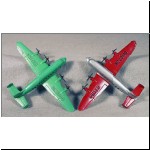 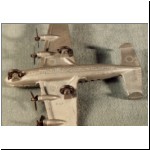      In 1939 the four engined Super Mainliner was given the catalogue number of DC-4, a novel departure from previous catalogue designations. The number was not cast on the model itself, however, and catalogue numbers most often were not told to retail customers. Luckily I did not take it to be a DC-5, being old enough by that time to have the sophisticated knowledge of such things that any adolescent is expected to display. SUPER MAINLINER - ANOTHER TOOTSIETOY was cast underneath. A military version appeared in 1941 numbered 722, with star roundels on the wings and ARMY TRANSPORT TOOTSIETOY cast underneath. There was also a version with LONG RANGE BOMBER TOOTSIETOY cast underneath (ref.14).  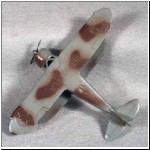  Also
in 1941, the Waco Bomber was modified to have DIVE BOMBER cast on top
of the wings in place of US NAVY. Also
in 1941, the Waco Bomber was modified to have DIVE BOMBER cast on top
of the wings in place of US NAVY. 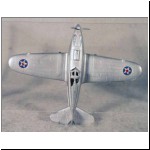  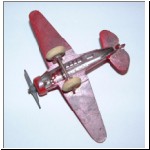 In 1941 a Curtis P-40 pursuit plane was added to the 5 cents line, but I didn't buy it then. A year or so later that small US Army transport on the right came out. This last plane is something of an enigma. The photo in Clint's original article shows a model identical to the US ARMY plane pictured here - but this one is clearly marked BARCLAY USA. Early examples of the Barclay had no maker's name, so probably Clint mistook the Barclay for a Tootsietoy. This mistake may be excusable in the light of Clint's concluding words. He wrote:- I didn't notice it then, and don't know what it is now. Once again, time and history had moved to shoulder toys into the shadow of seeming irrelevance. Perhaps we know better today? References (2) "To Tell the True T.T." in Modellers' World magazine, Vol.10 no.4 and Vol.11 no.1, July and October 1981. (4) The Book of Penny Toys by David Pressland, New Cavendish Books, 1991. (5) The Complete Book of Building and Collecting Model Automobiles by Louis H.Hertz, Crown Publishers Inc., New York, 1970. (10) Tootsietoys - World's First Diecast Models by James Wieland & Edward Force, Motorbooks International Publishers & Wholesalers Inc., Osceola, Wisconsin, 1980. (14) Diecast Toy Aircraft by Sue Richardson, New Cavendish Books, 1997. |
© Robert Newson

